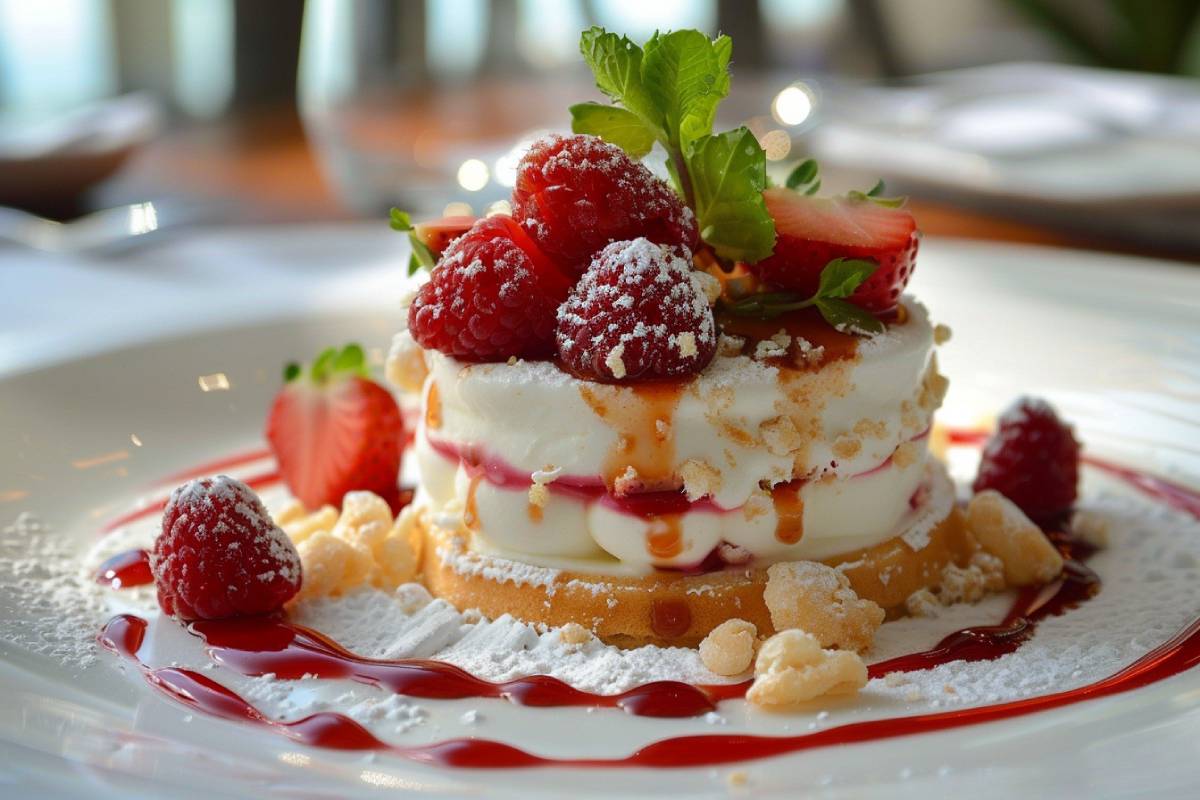Under the eye inflammation is a serious eye discomfort that can impair your eyesight in the long run and steal away from your beauty. For some under-eye inflammations, modern medicine proves unhelpful, which is why it is important that you know about the acupressure point for under-eye inflammation.
However, before we discuss these pressure points you should massage when you have under-eye inflammation, let’s give you a background on what constitutes under-eye inflammation.
Under-eye inflammation is a type of eye inflammation, and eye inflammation is any response the eyes make to infections, allergies, irritation, or even injuries. Eye inflammation can occur in any area of the eyes. So, typically, under-eye inflammation is the eye inflammation that occurs in the area below the eyes.
You mostly can’t be hundred percent sure that you would not have an under-eye infection because it is a prevalent medical condition that can happen to anyone at any age. The good thing about eye inflammation, however, is that it can be treated – although the length of treatment would then depend on the severity of the disease that is causing the eye inflammation.
You may lose your eyesight if the eye inflammation is caused by a serious disease. The trick is to detect under-eye inflammation early and attack it spot on. Acupressure and acupuncture treatment is very effective for under-eye inflammation, and in this article, I’ll show you the acupressure points for various types of under-eye inflammation.
Can Acupuncture Cure Eye Problems?

Yes, acupuncture is an effective treatment for eye problems. A large number of scientific studies (over 500 cases) have proved that acupuncture can successfully treat eye diseases. These studies showed the efficacy of acupuncture in treating eye conditions like retinitis pigmentosa, cataracts, surgical aphakia, and controlled glaucoma.
The positive effects of acupuncture on eye conditions are mostly seen in the central acuity rather than in the visual field, color vision, or night blindness. The reason for this is that acupuncture does not act on the entire retina. It acts on the macula alone. Hence, acupuncture shouldn’t stand as a substitute for prescribed medication or surgery for serious eye issues.
The efficacy of acupuncture in treating eye issues is in relieving symptoms. It cannot bring back a damaged tissue or organ.
What Causes Under Eye Inflammation?
There is no one cause of under-eye inflammation. Some of the causes of under-eye inflammation that would require the acupressure point for under-eye inflammation are eye infection, blocked tear duct, lack of sufficient sleep, taking too much salt, allergies, injuries, and excessive smoking.
What To Do If You Have Inflammation Under The Eye
If you have under the eye inflammation, you can just wait it out as it would normally go on its own. However, due to the discomfort it can cause, you can either choose to see your doctor, try some home remedies, or use facial acupressure.
Some home remedies for under the eye inflammation that have proved effective for some people include cold compresses and tea bags that contain caffeine. While these may be effective, massaging the acupressure points for under-eye inflammation is most effective, convenient, and easy to use.
Acupoints For Blepharospasm
Blepharospasm is a medical condition whereby the eyelids twitch or blink constantly in a way that is uncontrollable. This can be caused by long-term use of your PC or smartphone, mental stress, lack of sleep, and wearing contact lenses that don’t match. Below are the acupressure points to use when you have blepharospasm.
Acupoint: ST-1 (Other Names: Stomach-1/Cheng Qi/Tears Container)
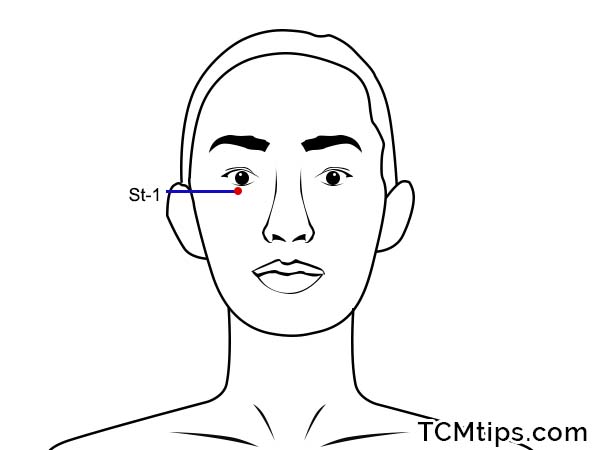
ST-1 is the foremost acupressure point for under-eye inflammation, especially when the case is blepharospasm. In Chinese, this pressure point is called Chengqi, which means Tear Container. The reason for this name is the location of the acupoint. You’ll find ST-1 just below the pupil of your eye, at the top of the bulging bone there called the infraorbital ridge.
In traditional Chinese Medicine (TCM), ST-1 is considered to be a dispeller of wind, a clearer of heat, and a stopper of lacrimation. The implication of this is that it can easily serve as a treatment protocol for eye issues like redness of the eyes, swellings, and any pain in the eyes. It is also one of the facial acupressure points for dark circles.
Acupoint: ST-2 (Other Names: Stomach-2/Si Bai/Four Whites)
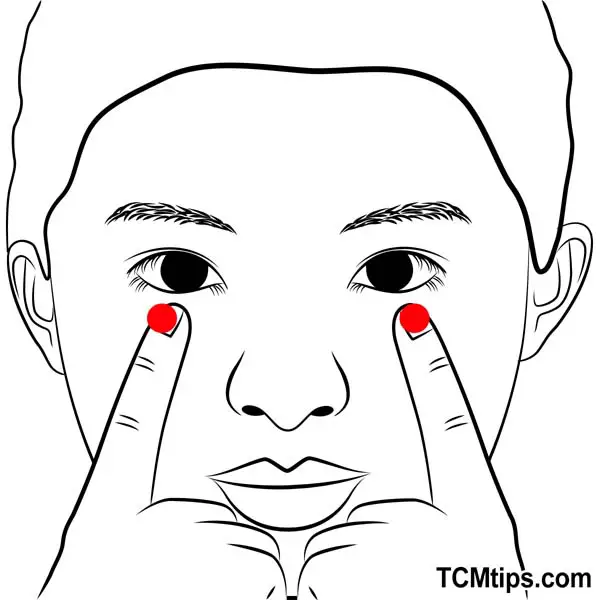
ST-2 is rightfully the next acupoint for blepharospasm. It is called Sibai in Chinese, which translates as Four Whites in English. As you may have guessed, ST-2 is directly below ST-1. You’ll find it in the tiny dent in the bulging bone below your eyes. You may not notice the dent at first, but when you rub the area in a circular motion with your middle finger, you’re sure to locate it.
Just like its sister, ST-1, Traditional Chinese Medicine believes that ST-2 functions as a dispeller of wind and a clearer of heat. This makes it effective in treating myopia, redness of the eyes, and of course twitching of the eyelids. ST-2 also serves as acupressure for seborrheic dermatitis.
You would have to be careful when massing both ST-1 and ST-2 because the skin around the eyes is thin. Apply gentle pressure on these acupoints and ensure to use clean hands to do this.
Acupoints For Stye
A stye is a small red swelling on the edge of your eyelid that can look like a pimple. Only it is more painful than a pimple. You get a stye when the glands in your eyelash follicle get blocked. Styes should go naturally, but when it doesn’t, it spread till it covers the entire eyelid. This is why you need an acupuncture treatment protocol as soon as you notice one. Now, here are the acupressure points for eye pain and stye.
Acupoint: LI-4 (Other Names: Large Intestine-4/He Gu/Joining Valley)

Acupuncture point LI-4 is a very popular pressure point. It is called Hegu in Chinese, and unlike the two acupoints before it, this pressure point is located on the hand. You would locate it between your thumb and index finger. It is in the muscles muscle that bulges there when you try to make a fist.
The location of Hegu does not in any way prevent it from being suitable for treating a stye. In fact, in TCM, Hegu is ideal for treating any disease of the head and face. Therefore, in addition to Stye, LI-4 is effective in treating headaches, eye pain, nosebleed, toothaches that affect the lower jaw, and facial paralysis.
LI-4 is also one of the acupressure points for skin inflammation that you can massage for instant relief.
Acupoint: LI-2 (Other Names: Large Intestine-2/Er Jian/Second Point)
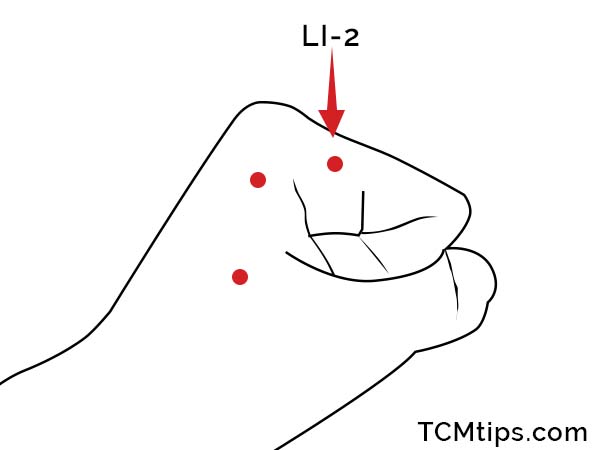
The next acupressure point for under-eye inflammation is L1-2 or Erjian, as it is called in Chinese. If you guessed that this acupoint is also located on the hand like LI-4, you’re very right. You’ll find Erjian on the index finger, at the edge of the wrinkles that form on the second joint when you bend your index finger.
In TCM, LI-2 functions as an acupoint for clearing heat, reducing swellings, and relieving pain. Hence, you can also use it to treat sore throat, toothache, and pain in the index finger, in addition to reducing eye pain and redness.
If you have congestive heart failure, massaging LI-2 is what you should do as it is one of the acupressure points for congestive heart failure.
Acupoint For Bags Under the Eyes
Bags under the eyes are not new to many people. They are swellings under the eyes that sometimes come as a result of old age and at other times as a result of sleep deprivation. When you have these bags under your eyes, fluid may accumulate there. In TCM, it is believed that when the blood flow in the body is stagnant, the blood flow around the eyes will also be stagnant, thus resulting in bags under the eyes and dark circles. Below is the acupoint to treat this condition.
Acupoint: EM-6 (Other Names: Qiu Hou)
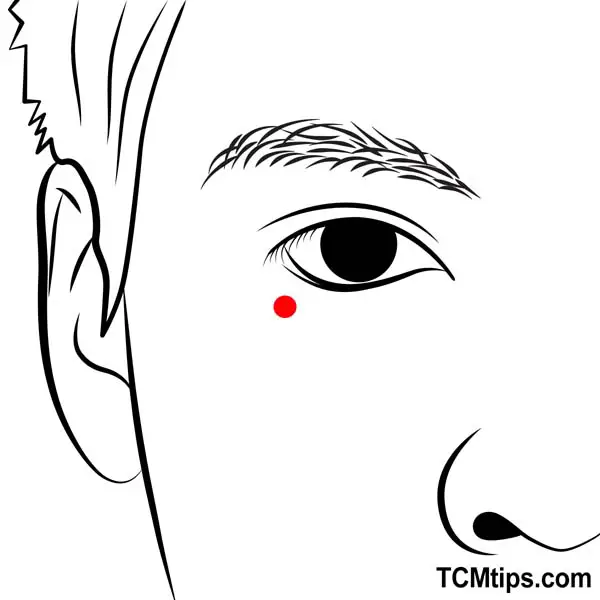
Acupressure point EM-6 is not a very popular pressure point. However, it is one of the effective acupressure points for under-eye inflammation. It is called Qiuhou in Chinese, which means Behind the Ball. This name is just apt because this acupoint is located at the outer corner of the eye, on the bulging bone below the eyes. In fact, it is at the position where your tears would normally flow.
Due to its location, Qiuhou is suitable for treating a number of eye diseases, including optic neuritis, glaucoma, myopia, and cataract in the early stages. If you have dry eyes, these are the acupressure points for dark circles that you need.
When you stimulate EM-6, your internal organs begin to function better, your hormones become adjusted, your body and mind become balanced, and the overall condition of your skin is improved.
 P. Sze
P. Sze 






